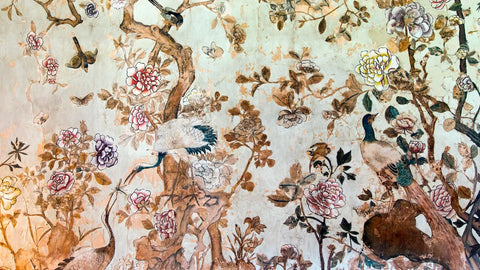Dive into the origins of wallpaper and discuss how its usage has evolved over time.
Wallpaper has adorned our walls for centuries, adding color, pattern, and texture to living spaces. But have you ever wondered about its origins and how it has evolved over time? Journey with us as we explore the rich history of wallpaper, from its beginnings in ancient China to the diverse and innovative designs we see today.
Ancient China: The Birthplace of Wallpaper
The earliest known use of wallpaper dates back to ancient China around 200 B.C. The Chinese invented a form of papermaking, and they began to use rice paper to decorate their walls. They would either hang plain sheets or paint intricate designs directly onto the paper. These early wallpapers were a symbol of wealth and status, as only the affluent could afford such decorations.

Middle Ages and Renaissance Europe
Wallpaper made its way to Europe in the Middle Ages, but it wasn't until the Renaissance that it gained popularity among the aristocracy. Europeans initially used textiles such as tapestries and fabric wall hangings to adorn their walls. However, these materials were expensive and difficult to maintain. Wallpaper provided a more cost-effective and versatile alternative.
In the 15th and 16th centuries, block printing was the primary method for creating wallpaper designs. Craftsmen would carve designs into wooden blocks and press them onto paper with ink or paint. This labor-intensive process resulted in limited and expensive wallpaper options, making them accessible only to the wealthy.

The Industrial Revolution: Wallpaper for the Masses
The Industrial Revolution brought significant advancements in wallpaper production, making it more affordable and available to a wider audience. In the late 18th century, the invention of the wallpaper printing press and the development of continuous paper rolls allowed for faster and more efficient production. These innovations led to a boom in wallpaper popularity, as it became an accessible and stylish option for the middle class.

Victorian Era: A Time of Opulence and Ornamentation
During the Victorian era, wallpaper designs became increasingly elaborate and detailed. Heavy patterns, rich colors, and intricate motifs such as florals, birds, and scenes from mythology were popular choices. The invention of machine printing allowed for the mass production of these intricate designs, while the introduction of synthetic dyes provided a wider range of vibrant colors.

20th Century: A Shift in Styles and Techniques
The 20th century saw a departure from the heavy, ornate designs of the Victorian era. The Art Nouveau, Art Deco, and Mid-Century Modern movements introduced cleaner lines, geometric patterns, and abstract shapes to wallpaper designs. During this time, wallpaper also became more durable and easier to clean, thanks to the development of vinyl-coated materials.

The Digital Revolution: Customization and Endless Possibilities
Today, the wallpaper industry continues to evolve, with digital printing technology allowing for unparalleled levels of customization and creativity. Homeowners can now choose from an almost infinite array of designs, colors, and textures, or even create their own unique patterns using personal photographs and images.
The history of wallpaper is a fascinating journey that reflects the changing tastes, styles, and innovations of each era. From the simple rice paper decorations of ancient China to the vibrant and diverse options available today, wallpaper remains a popular and ever-evolving way to express our personal style and transform our living spaces.


